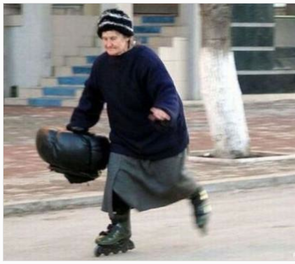
We often consider that staying in place is just about homes and houses. However, cities and towns can be designed to provide people of all ages and abilities with options on how and where to live.
In an article by Minnesota Public Radio just published, an expert panel identified 5 ways communities can prepare to take care of their residents.
1. Cities and towns should make neighborhoods more accessible as their population ages and can't rely on cars for independent transportation.
"The majority of older adults live in suburban environments," said Andrew Scharlach, professor of aging at University of California, Berkeley. "They basically live in the environments that they raised children in or they came to live in with their children. They tend to be highly automobile dependent."
Approximately 90 percent of all trips by older adults are in an automobile, he said. When they can no longer drive themselves, they tend to become socially isolated.
Scharlach said communities need to make more amenities accessible by foot.
2. Make it financially easier for seniors to transition into different housing if that is the best option for their needs.
Rebecca Cohen, senior policy analyst at the Bipartisan Policy Center, said it's important to remember this isn't just about building more senior housing.
"Senior housing is part of a full continuum of housing policy," she said. "In some cases you have folks who may be in homes that are no longer appropriate for their needs, but they may be locked in because they are underwater on their mortgage and they are unable to sell the home at an amount that enables them to move out or they may be unable to find new homebuyers."
3. Build or modify homes so they are more friendly to aging owners.
Cohen said new homes should be built with aging in mind and existing homes can be updated with simple additions that add safety for seniors. The U.S. Department of Housing and Urban Development has a list of 11 home modifications for seniors, which includes levered doorknobs, grab bars in bathrooms and movable shower heads.
4. Improve a sense of community for all residents.
While many seniors are attached to their homes and determined to stay there, it can be a challenge socially, said a home health aide who called the show.
"Their lives are so bleak," she said. "They will go all day without seeing anybody. Maybe one or two hours a day they'll see their home health aide, they'll see the Meals on Wheels person for five minutes at the door."
Scharlach said people often become invisible as they develop physical and social losses, but community support can improve their lives.
"Think about the way community perhaps once was in many parts of the world, the way it still is in some parts of the world, where you knew your neighbors," he said. "Where if Mrs. Smith or Mrs. Jones was down the block and you knew she was isolated, you'd stop by there every so often to see how she was doing or give her a call. If you saw her newspaper hadn't been picked up, you'd go knocking on the door to find out what was going on. In a very fundamental way, this is about rebuilding a sense of community and that is good not just for seniors, but for all of us."
5. Consider adding alternative housing options and programs.
• Granny flats: Multi-generational housing, where another unit is added to a lot to accommodate additional family members while still maintaining privacy.
• Co-op community programs: Mill City Commons in Minneapolis was one member-based organization noted for bringing people together to help one another.
• Senior trailer parks :
Seniors who can live on their own cost the country relatively little — they even contribute to the economy. But those who move into nursing homes start to run up a significant tab — starting at $52,000 a year. People who are isolated and lonely end up in nursing homes sooner. Hence, finding ways to keep people living on their own, socially engaged, healthy, happy, and out of care isn't just a personal or family goal — it's a national priority. Among seniors' living options, there is one we overlook: mobile homes. Time-tested, inhabited by no fewer than three million seniors already, but notoriously underloved, manufactured-homes can provide organic communities and a lifestyle that is healthy, affordable, and green, and not incidentally, fun. (Pacific Standard)
In an article by Minnesota Public Radio just published, an expert panel identified 5 ways communities can prepare to take care of their residents.
1. Cities and towns should make neighborhoods more accessible as their population ages and can't rely on cars for independent transportation.
"The majority of older adults live in suburban environments," said Andrew Scharlach, professor of aging at University of California, Berkeley. "They basically live in the environments that they raised children in or they came to live in with their children. They tend to be highly automobile dependent."
Approximately 90 percent of all trips by older adults are in an automobile, he said. When they can no longer drive themselves, they tend to become socially isolated.
Scharlach said communities need to make more amenities accessible by foot.
2. Make it financially easier for seniors to transition into different housing if that is the best option for their needs.
Rebecca Cohen, senior policy analyst at the Bipartisan Policy Center, said it's important to remember this isn't just about building more senior housing.
"Senior housing is part of a full continuum of housing policy," she said. "In some cases you have folks who may be in homes that are no longer appropriate for their needs, but they may be locked in because they are underwater on their mortgage and they are unable to sell the home at an amount that enables them to move out or they may be unable to find new homebuyers."
3. Build or modify homes so they are more friendly to aging owners.
Cohen said new homes should be built with aging in mind and existing homes can be updated with simple additions that add safety for seniors. The U.S. Department of Housing and Urban Development has a list of 11 home modifications for seniors, which includes levered doorknobs, grab bars in bathrooms and movable shower heads.
4. Improve a sense of community for all residents.
While many seniors are attached to their homes and determined to stay there, it can be a challenge socially, said a home health aide who called the show.
"Their lives are so bleak," she said. "They will go all day without seeing anybody. Maybe one or two hours a day they'll see their home health aide, they'll see the Meals on Wheels person for five minutes at the door."
Scharlach said people often become invisible as they develop physical and social losses, but community support can improve their lives.
"Think about the way community perhaps once was in many parts of the world, the way it still is in some parts of the world, where you knew your neighbors," he said. "Where if Mrs. Smith or Mrs. Jones was down the block and you knew she was isolated, you'd stop by there every so often to see how she was doing or give her a call. If you saw her newspaper hadn't been picked up, you'd go knocking on the door to find out what was going on. In a very fundamental way, this is about rebuilding a sense of community and that is good not just for seniors, but for all of us."
5. Consider adding alternative housing options and programs.
• Granny flats: Multi-generational housing, where another unit is added to a lot to accommodate additional family members while still maintaining privacy.
• Co-op community programs: Mill City Commons in Minneapolis was one member-based organization noted for bringing people together to help one another.
• Senior trailer parks :
Seniors who can live on their own cost the country relatively little — they even contribute to the economy. But those who move into nursing homes start to run up a significant tab — starting at $52,000 a year. People who are isolated and lonely end up in nursing homes sooner. Hence, finding ways to keep people living on their own, socially engaged, healthy, happy, and out of care isn't just a personal or family goal — it's a national priority. Among seniors' living options, there is one we overlook: mobile homes. Time-tested, inhabited by no fewer than three million seniors already, but notoriously underloved, manufactured-homes can provide organic communities and a lifestyle that is healthy, affordable, and green, and not incidentally, fun. (Pacific Standard)

 RSS Feed
RSS Feed